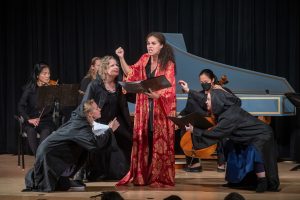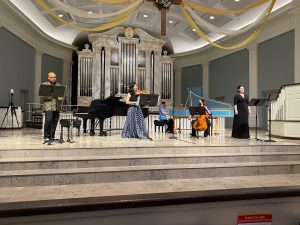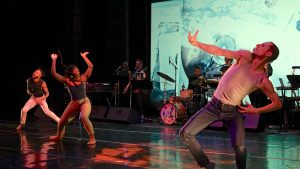Collaboration in the arts is not a choice: These days, it’s practically a necessity. In recent decades, Kansas City’s arts groups have noticeably moved toward a collaborative model, to the point where on any given night you are likely to partake of a performance of music, theater, or dance that involves multiple non-profit arts groups working together.
“What we gain is a kind of adventurousness of spirit, a congeniality,” said Elizabeth Suh Lane, whose Bach Aria Soloists have worked frequently with the Owen/Cox Dance Group, Heart of America Shakespeare Festival, The Nelson-Atkins Museum of Art, Kansas City Public Libraries, and jazz greats such as Bobby Watson and Rodney Marsalis.

Elaine Clifford, Kendra Keller, Meredith Wolfe and Cinnamon Schultz, as the three Witches and Lady Macbeth, perform a scene from Macbeth with musicians Elizabeth Suh Lane, Elisa Williams Bickers, and Hannah Collins. / Photo by Dean Davison
“That’s what chamber music is about, after all, so it’s very natural for us to reach out to what can sometimes be unusual partnerships.”
The sheer unpredictability of the outcome is half the fun. “You don’t know exactly what you’re going to get,” Elizabeth said. “It’s worth the risk.”
This January the 13th, Bach Aria Soloists joins with Heart of America Shakespeare Festival and Midwest Trust Center for Women of Note in Words and Song, a pointed illustration of how these synergistic efforts can work.
“Collaborators aren’t born, they’re made,” wrote choreographer Twyla Tharp in her 2013 book The Collaborative Habit: Life Lessons for Working Together. “Or, to be more precise, built, a day at a time, through practice, through attention, through discipline, through passion and commitment: and most of all, through habit.”
For Tharp as for many pioneering performing artists, seeking out partner-creators whose aesthetics and even world-view might be markedly different from one’s own is crucial to a continued renewal and regeneration of the arts.
Focused “brainstorming” can inspire innovations that simply could not have happened if each group had been flying solo, as arts groups large and small are learning.

Trumpeter Rodney Marsalis was the special guest at the April 2022 concert of the Bach Aria Soloists: Elizabeth Suh Lane, Elisa Williams Bickers, Hannah Collins, and Sarah Tannehill Anderson. / Photo by Virginia Olsen
For the Women of Note program, the Shakespeareans and the Bachians were both determined to think well outside the norm: Scenes from Shakespeare involving only women characters have been juxtaposed with music appropriate to the mood of each, composed entirely by women: Hildegard von Bingen, Cecilia McDowall, Barbara Strozzi, Susan Kander, and Élisabeth Jacquet de La Guerre.
And because the core members of Bach Aria Soloists are all women, it turns out that poor Will S. is the only man involved.
“It is a way to bring two seemingly disparate things together to make a program that will be more impactful for everyone, and reach different audiences,” said Sidonie Garrett, executive artistic director of the Shakespeare Festival, who has selected scenes involving some of the bard’s most complex and fascinating women. “Music and text have to able to stand alone, as well as work together in a way that they speak to each other, and to an audience,” she added.
In this instance, Elizabeth chose the music for the all-female program first, then passed it to Sidonie. The music led Sidonie to scenes that match the music: mournful, sad, joyous, energetic. “My job was to put together a program that makes sense dramatically and emotionally,” she said.
Included are all-female scenes from Macbeth, As You Like It, King Lear, Hamlet, Taming of the Shrew, A Midsummer Night’s Dream, Twelfth Night, Othello, The Merry Wives of Windsor, and other plays. Because collaborations draw fans of all groups involved, they become significant audience-building tools.

Guitarist Beau Bledsoe joined Bach Aria Soloists musicians Elisa Williams Bickers, Elizabeth Suh Lane, and Sarah Tannehill Anderson at the Nelson-Atkins Museum of Art.
At a similar Shakespeare Festival/Bach Aria Soloists collaboration last year, Elizabeth noticed that “there were definitely people there who had never been to our concerts, and others who had never been to theirs.” What better way for all organizations involved to envision new programming and at the same time build audiences?
“These are great characters,” Sidonie said of the bard’s women. From poor Ophelia (“who is in love with someone who seems to have lost his mind”) to Queen Margaret (“a battle-ax who is going to have a man killed because she can”) and the wives of Windsor (“middle-aged gals who are just fed up with men in general”), these women are drawn with uncanny insight. And music can underscore this. Susan Kander’s Sometimes I Feel Like a Motherless Child, for instance, is performed as a wry if apt commentary on Will’s women.
“There are no mothers of the women in Shakespeare,” Sidonie said. “Ophelia has no mother, the daughters of Lear have no mother, Celia and Rosalind (As You Like It) have no mothers.”
Certain art forms are more inclined toward collaboration than others: Opera, dance, and other forms of theater always involve many moving parts. “Dance is innately collaborative,” said Jennifer Owen, co-founder of Owen/Cox Dance Group: another ensemble that earns kudos for daring ventures with vocalists, chamber ensembles, dancers, and visual artists.

Owen/Cox Dance Group dancers Christian Warner, Emara Neymour Jackson, and Sam McReynolds perform aRound & aRound, inspired by the art of Nate Fors; in back (and only partially visible) are musicians Leigh Gibbs, Jeff Freling, Kelley Gant, Brian Steever, Brad Cox, and Jeff Harshbarger. / Photo by Lindsay Clipner
“We’re looking for artists we can work with to create something different from what we might normally produce,” Jennifer added, “and to that end we like to collaborate with people who are open-minded … and who produce excellent work.” An artistic team is like a relationship, “and thus I’d like for the collaborative space to reflect the kind of world we’d like to live in: where there is respect, where people feel comfortable sharing their views. A welcoming and safe experience, just the way we’d like the world to be.”
Collaborative art takes many forms, but it begins with people and institutions that look outward. “It’s about having conversations with each other,” Sidonie said. “And that means getting out of your silo long enough to get to these arts lunches and other places where arts leaders are together. … The more I get out and talk to people, the more things seem possible, and the more ideas we have together.”
For its Silver Anniversary, the Shakespeare Festival hosted a “25 for the 25th,” a wide ranging series of events in collaboration with every conceivable local institution. “Whenever I’ve started the conversation of ‘Hey what do you think about this idea?’ it’s always been met with ‘Yeah, let’s see what can happen,” Sidonie said. “Every single time.” And usually something wonderful is waiting, just around the corner.
—By Paul Horsley
Cover photo: Ashlee LaPine as Olivia and Elaine Clifford as Viola perform from Twelfth Night, with Bach Aria Soloists musicians Elizabeth Suh Lane, Elisa Williams Bickers, and Hannah Collins. / Photo by Dean Davison
For tickets to Women of Note in Words and Song, call 913-469-4445, or go to jccc.edu/midwest-trust-center. To reach Paul Horsley, performing arts editor, send an email to paul@kcindependent.com or find him on Facebook (paul.horsley.501) or Twitter/Instagram (@phorsleycritic).